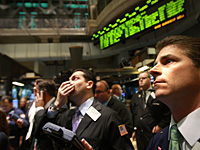
This article was last updated on April 16, 2022
Canada: ![]() Oye! Times readers Get FREE $30 to spend on Amazon, Walmart…
Oye! Times readers Get FREE $30 to spend on Amazon, Walmart…
USA: ![]() Oye! Times readers Get FREE $30 to spend on Amazon, Walmart…
Oye! Times readers Get FREE $30 to spend on Amazon, Walmart…
 A year ago the Dow Jones Industrial Average crashed almost 1,000 points in a matter of minutes for reasons still yet unknown, shaking investor confidence and renewing concerns about the fragility of our economy and financial markets.
A year ago the Dow Jones Industrial Average crashed almost 1,000 points in a matter of minutes for reasons still yet unknown, shaking investor confidence and renewing concerns about the fragility of our economy and financial markets.Since then, the Dow has made back that drop and then some, climbing 17 percent since that May 5th ‘Flash Crash.’ But despite this recovery, a broad range of strategists, investors and analysts fear a 10 percent-plus sell-off may be ahead, it just may take more than 15 minutes to unfold.
They cite increased leverage that indicates the hot money is still at the controls a year later and has already caused a 3-day ‘Flash Crash’ in the silver market. A peak in the economic recovery and the June end to the Federal Reserve’s purchases of $600 billion in Treasury securities are also among the reasons cited.
"We expect a pullback of roughly 10 percent in the S&P 500 this summer after the Federal Reserve stops growing its holdings of long-dated securities," said Doug Cliggot, chief U.S. equity strategist at Credit Suisse, who called the tech bubble pop a decade ago while at JPMorgan Chase. "Our profit margin indicators – the rate of change in private sector compensation and the rate of change in the costs of intermediate goods – are flashing bright yellow this spring."
After a drop Wednesday, the Dow is off a little more than 1 percent from its bull market high reached earlier in the week. Silver futures, on the other hand, are down 18 percent from their Friday close.
Even though this hasn’t held true in recent years, the stock market is entering a rather weak period seasonally. Since 1950, the Dow has provided zero return, on average, from May through October, according to Alan Newman, author of the Crosscurrents newsletter. Newman also has another reasons why the market is particularly ripe for a selloff this May: the amount of borrowing used to buy stocks.
"Margin debt was up another $7.4 billion in March and now there are only nine months in which the level of leverage has ever been higher," wrote Newman in his latest newsletter. "Borrowed money was the basis for the housing bubble, borrowed money is the basis for the newest stock bubble."
Stocks fell Wednesday after a measure of the service economy came in weaker than expected. That number followed disappointing employment data from private payroll services firm ADP. The official government jobs report for April is out this Friday.
In a note to clients making the rounds on trading floors this morning, Goldman Sachs hinted that the peak in the U.S. business cycle may be nearing, meaning its time for investors to reallocate to more defensive sectors and single stocks with big international sales. They cited the slowing rate of growth in the manufacturing economy by the Institute for Supply Management.
"The ISM has posted four straight months above 60 and its highest level since 1983," wrote David Kostin, Goldman’s portfolio strategist. "However, the rate of acceleration has slowed to neutral relative to last year."
"Once the ISM peak has been reached and the rate of expansion is moving back towards neutral, historical performance supports more defensive positioning," added Kostin.
To be sure, the bulls argue that the stock market is forecasting brighter times ahead, continuing its rise through turmoil in the Middle East, a nuclear crisis in Japan and political infighting over future fiscal plans.
"This market and economy is very resilient," said Brian Kelly of Brian Kelly Capital. "Imagine how strong it would be if Japan and the Middle East did not occur."
Still others believe a pullback of significant magnitude is inevitable, given that most of the market forces that are believed to have caused the May 5th crash have yet to be adequately addressed.
"Once again, the silver market shows the effects of what happens in a market when the momentum shift happens," said David Greenberg of Greenberg Capital. "The electronic market just makes the move that much faster."
For the best market insight, catch ‘Fast Money’ each night at 5pm ET and the ‘Halftime Report’ each afternoon at 12:30 ET on CNBC.

Be the first to comment